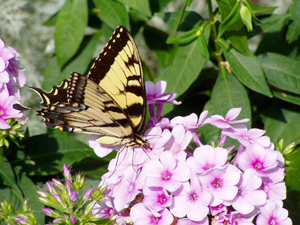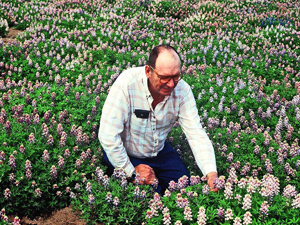|
‘John Fanick’ phlox is pretty in pink
|
written by
Greg Grant
Greg Grant is the Smith County Horticulturist for the Texas A&M AgriLife Extension Service on July 4, 2018.
He is author of "In Greg’s Garden: A Pineywoods Perspective on Gardening, Nature, and Family." You can read his “Greg’s Ramblings” blog at arborgate.com or read his “In Greg’s Garden” in each issue of Texas Gardener magazine (texasgardener.com). More science-based gardening information from the Texas A&M AgriLife Extension Service can be found at aggie-horticulture.tamu.edu.

Greg Grant and John Fanick Phlox
|
Greg Grant writes: “I’ve been dabbling with plant introduction my entire career.”
Luther Burbank planted the idea in my head but friend and mentor Dr. Jerry Parsons showed me the way.
Of course not all plant introductions are successful. For plants to be successful in the nursery trade they need to be either showy in the container or very showy in the garden. They also have to be easy enough for the wholesale nurseryman to propagate.
And it certainly helps if they are adapted to our Texas climate. That’s where I come in.
Many of the plants sold in retail garden centers were developed for Europe and the northern U.S. Very few were specifically developed for the South and almost none were specifically developed for Texas.
Ironically, John Fanick phlox was found while driving around old neighborhoods near my $1 a month east side San Antonio residence when I worked as the director of new product development at the former Lone Star Growers there.
|
It came from a modest home on Rigsby Street on the southeast side. I had always been on the lookout for Phlox paniculata (often referred to as “standing phlox” or “garden phlox”) in Texas gardens, as the popular clones in the trade were all bred and selected in Europe and don’t survive our Texas summers or repeated bouts of powdery mildew.
It’s amazing to me that a plant native to the heat and humidity of the southeastern U.S. could be taken back to Europe, turned from magenta into an array of showy colors, and then no longer grow in the South where it came from.
|
It’s a very good lesson in plant breeding. Native species can be taken to dissimilar climates and evolve into “native” species that are no longer adapted to the area they came from originally.
Remember, most of Europe and the North have cold winters and mild summers. We very much have the opposite. Generally the only garden phlox you find in Texas and the South are magenta pink forms similar to the original wild forms.
So imagine my surprise when I see a whole row of compact light pink phlox growing in the middle of a St. Augustine grass yard, with half of the row under a live oak and half in the full sun.
Luckily the elderly lady let me propagate it and bring it back to the nursery. It’s a lucky thing I did, as both the lady, the home and the garden soon vanished forever. It was truly a unique phlox. It was heat tolerant, cold tolerant, mildew tolerant, fragrant and compact.
|

Tiger Swallowtail on Fanick's Phlox
|

John Fanick in Lavender bluebonnets later named Barbara Bush
I named it for my late San Antonio nursery friend, John Fanick. from the legendary Fanick’s Nursery. It became a proven performer in other Texas gardens and was later designated a Texas Superstar. For information on other trademark Texas Superstar selections go to texassuperstar.com.
|
|
|
|



